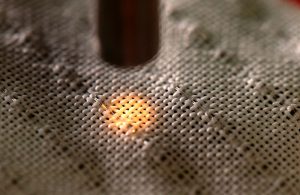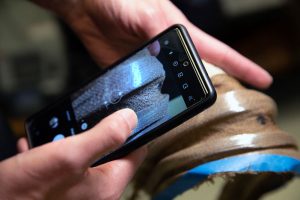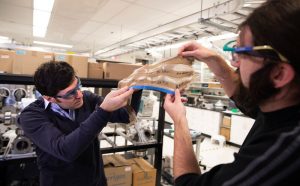
Photonic fibers borrow from butterfly wings to enable invisible, indelible sorting labels.
TW Special Report
Less than 15 percent of the 92 million tons of clothing and other textiles discarded annually are recycled — in part because they are so difficult to sort. Woven-in labels made with inexpensive photonic fibers developed by a University of Michigan-led team could change that.
“It’s like a barcode that’s woven directly into the fabric of a garment,” said Max Shtein, a U-M professor of materials science and engineering and corresponding author on the study. “We can customize the photonic properties of the fibers to make them visible to the naked eye, readable only under near-infrared light or any combination.”
Ordinary tags often don’t make it to the end of a garment’s life — they may be cut away or washed until illegible, and tagless information can wear off. Recycling could be more effective if a tag was woven into the fabric, invisible until it needs to be read. This is what the new fiber could do.
Recyclers already use near-infrared sorting systems that identify different materials according to their naturally occurring optical signatures — the PET plastic in a water bottle, for example, looks different under near-infrared light than the HDPE plastic in a milk jug. Different fabrics also have different optical signatures, but Brian Iezzi, a postdoctoral researcher in Shtein’s lab and lead author on the paper, explains that those signatures are of limited use to recyclers because of the prevalence of blended fabrics.
 “For a truly circular recycling system to work, it’s important to know the precise composition of a fabric — a cotton recycler doesn’t want to pay for a garment that’s made of 70-percent polyester,” Iezzi said. “Natural optical signatures can’t provide that level of precision, but our photonic fibers can.”
“For a truly circular recycling system to work, it’s important to know the precise composition of a fabric — a cotton recycler doesn’t want to pay for a garment that’s made of 70-percent polyester,” Iezzi said. “Natural optical signatures can’t provide that level of precision, but our photonic fibers can.”
The team developed the technology by combining Iezzi and Shtein’s photonic expertise — usually applied to products like displays, solar cells and optical filters — with the advanced textile capabilities at MIT’s Lincoln Lab. The lab worked to incorporate the photonic properties into a process that would be compatible with large-scale production.
They accomplished the task by starting with a preform — a plastic feedstock that comprises dozens of alternating layers. In this case, they used acrylic and polycarbonate. While each individual layer is clear, the combination of two materials bends and refracts light to create optical effects that can look like color. It’s the same basic phenomena that gives butterfly wings their shimmer.
The preform is heated and then mechanically pulled — a bit like taffy — into a hair-thin strand of fiber. While the manufacturing process method differs from the extrusion technique used to make conventional man-made fibers like polyester, it can produce the same miles-long strands of fiber. Those strands can then be processed with the same equipment already used by textile makers.
By adjusting the mix of materials and the speed at which the preform is pulled, the researchers tuned the fiber to create the desired optical properties and ensure recyclability. While the photonic fiber is more expensive than traditional textiles, the researchers estimate that it will only result in a small increase in the cost of finished goods.

“The photonic fibers only need to make up a small percentage — as little as 1 percent of a finished garment,” Iezzi said. “That might increase the cost of the finished product by around 25 cents — similar to the cost of those use-and-care tags we’re all familiar with.”
Shtein says that in addition to making recycling easier, the photonic labeling could be used to tell consumers where and how goods are made, and even to verify the authenticity of brand-name products. It could be a way to add important value for customers.
“As electronic devices like cell phones become more sophisticated, they could potentially have the ability to read this kind of photonic labeling,” Shtein said. “So I could imagine a future where woven-in labels are a useful feature for consumers as well as recyclers.”
The team has applied for patent protection and is evaluating ways to move forward with the commercialization of the technology.
The research was supported by the National Science Foundation and the Under Secretary of Defense for Research and Engineering.
Study: “Fabric-Integrated Polymeric Photonic Crystal Fibers for Textile Tracing and Sorting” (DOI: https://doi.org/10.1002/admt.202201099)
February 9, 2023




